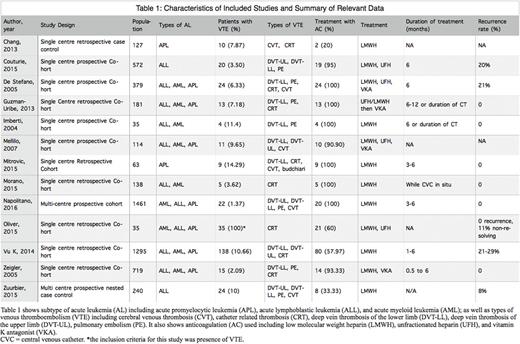Abstract
Background: Patients with hematologic malignancies are up to 26 times more likely to develop venous thromboembolism (VTE) than the general population. The standard treatment for VTE is anticoagulation, however, it's safety and efficacy in this patient population has not been formally evaluated. In addition, severe thrombocytopenia and coagulopathies in patients with hematologic malignancies makes treatment of VTE challenging and the optimal treatment strategy for VTE in this patient population is unclear.
Methods: We conducted a systematic review of the literature aiming to identify observational studies and randomized trials describing treatment of VTE in the setting of acute leukaemia (AL) including, acute myeloid leukemia (AML), acute promyelocytic leukemia (APL), and acute lymphoblastic leukemia (ALL). Due to the heterogeneity of findings, no meta-analysis was attempted.
Results: A total of 13 observational studies, including 11 cohort studies and 2 case control studies, were included with 5,359 participants. Number of patients who developed VTE among the total population was 330 (6.2%; 95% CI 5.5-6.8). Of patients with VTE, 229 patients received treatment with anticoagulation. Agents used for anticoagulation included low-molecular-weight heparin (LMWH), unfractionated heparin (UFH), and vitamin K antagonists (VKA). Despite lack of consensus, most studies adjusted dose of anticoagulant based on platelet (PLT) counts. Most commonly, LMWH dose was reduced by 50-75% for PLT counts less than 50 X 109 /L. Many studies temporarily held anticoagulation in the face of severe thrombocytopenia (PLT <10 X 109/L) refractory to transfusions. Platelet transfusions were often used to maintain PLT count at a safe cut off. The recurrence rate reported varied among different studies based on duration of treatment with anticoagulation and duration of follow up. Recurrence ranged from 0 to 29% in different studies. Reported bleeding rate in the literature was sporadic; however, no studies reported a statistically significant higher risk of bleeding among anti-coagulated patients.
Conclusion: In summary, our systematic review obtained information about different anticoagulation regimens used for treatment of VTE in AL patients, highlighting the significant lack of data in this area. In addition, there is a high degree of heterogeneity in choice of anticoagulant, dose adjustments in the face of thrombocytopenia, duration of anticoagulation and bleeding and recurrence rates. Further studies are required to develop guidelines and suggestions for treatment of VTE in AL.
Lazo-Langner: Daiichi Sankyo: Research Funding; Pfizer: Honoraria; Bayer: Honoraria; Alexion: Research Funding.
Author notes
Asterisk with author names denotes non-ASH members.


This feature is available to Subscribers Only
Sign In or Create an Account Close Modal